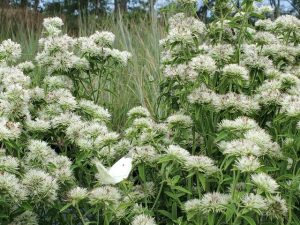Considering planting a Pocket Meadow?
Congratulations on taking the first steps toward making your yard a better place for you and the wildlife that calls it home. You are joining the growing movement of gardening for wildlife conservation – a grass roots movement of turning underutilized suburban and urban spaces into a patch work of valuable wildlife habitat.
Because native plants have evolved to live in our ecosystem, they are easy to care for. The need for minimal maintenance makes our meadow kit perfect for gardeners of all skill levels and those who don’t have much time to tend to their gardens. The native plants in our Pocket Meadow Kit have been chosen for their ease of care, beauty and outstanding wildlife benefits. These plants will provide food, shelter and places to rear young for many species of insects and birds, thus bringing a little bit of tranquility to your outdoor space even in the most urban environment. Your meadow will change seasonally so there will always be something new to look at. Like all landscape projects the most important part is to have fun and enjoy what you are creating.
The mix will vary based on seasonal relevance and availability. The kit will have 10 plants consisting of at least 2 varieties of grasses and 3 varieties of flowering perennials. Our Pocket Meadow kit will contain any combination of the following plant species:
SITE SELECTION:
The first step in creating your meadow is to find a suitable location. The plants in the kit are highly adaptable, growing in full sun to light shade in a variety of soil conditions. They can be planted in a sunny corner of your yard, an empty bed along a fence, a balcony container garden or sidewalk hell strip.
SITE PREPARATION:
Once you have chosen your planting location, assess your site. Assess any current vegetation and remove anything unwanted. If your soil is highly compacted, loosen the soil with a shovel. No need to incorporate organic amendments into the soil. These plants are tough and do not need extra coddling! If not highly compacted, plant into undisturbed ground. This has the advantage of lessening weed pressure by not stirring up and exposing weed seeds lying dormant in the soil. Think of it as no-till agriculture for your meadow!
PLANTING:
There are no hard and fast rules as to how you arrange plants. You may want to plant the taller plants towards the back and the short ones towards the front although you can arrange your meadow plants in any way you like. Plant your garden densely with plants spaced at 12” on center. Native plants do best when there is some competition with each other. This helps them set deep roots and will keep them from flopping over in the snow and rain. Planting densely also helps control weeds by minimizing the amount of ground space weeds can grow in. Add a layer of mulch at planting. This will help keep the weeds at bay and help keep the soil moist and add additional organic matter as it breaks down.
WATERING:
After you have planted and mulched, give your new meadow a thorough watering. Periodically re-apply water as needed through the first growing season. After that your plants will only require watering during the most severe drought conditions.
MAINTENANCE:
Your pocket meadow will require very little maintenance. Especially during the first season, pull any weeds that pop up. Because you planted densely, there will not be much room for weeds once plants are established. Each spring, cut your meadow down to 6 – 8” tall. You can use the material you cut down as mulch in your meadow or add it to your compost pile.
Once your meadow is complete you can register it with HomeGrownNationalPark.org. There you will find a community of people like yourself that are also doing their part to conserve our natural world. Enjoy!




